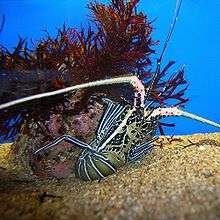Panulirus versicolor
| Panulirus versicolor | |
|---|---|
 | |
| Scientific classification | |
| Kingdom: | Animalia |
| Phylum: | Arthropoda |
| Subphylum: | Crustacea |
| Class: | Malacostraca |
| Order: | Decapoda |
| Family: | Palinuridae |
| Genus: | Panulirus |
| Species: | P. versicolor |
| Binomial name | |
| Panulirus versicolor (Latreille, 1804) | |
Panulirus versicolor is a species of spiny lobster that lives in tropical reefs. Other names include painted rock lobster, common rock lobster, bamboo lobster, blue lobster, and blue spiny lobster. P. versicolor is one of the three most common varieties of spiny lobster in Sri Lanka, alongside Panulirus homarus and Panulirus ornatus.[2]
Morphology
P. versicolor grows up to 40 centimetres (16 in) long, but is typically no more than 30 cm (12 in).[3] It has no claws, two spiny rostra over the eyes, and two pairs of large antennae, like all spiny lobsters. The first pair of antennae are double ended, the second hard and spiny, both are usually white. The carapace is white, pink and black, with horizontal bands and a reticule. The abdomen is green with transverse black and white bands. The legs are dark brown with white stripes and the tail is blue-green.
Behaviour
P. versicolor is nocturnal and solitary.[3] In the daytime they hide in small caves and crevices in reefs or under coral at depths up to 15 metres (49 ft).[3] They are carnivores, eating both carrion and fresh caught arthropods, other crustaceans, and occasional small fish.
Geographic distribution
P. versicolor occurs in the shallow tropical waters of the western Pacific and the Indian Ocean. In the Indian Ocean it occurs from as far south on the east coast of Africa as Natal, up through the Red Sea and Persian Gulf, in the Arabian Sea across to India, Myanmar, Thailand, and Malaysia, down through Indonesia to the waters of north-western Australia. In the western Pacific it occurs as far north as southern Japan, throughout Micronesia, Melanesia, Polynesia and in the waters of north-eastern Australia.
Economic uses
Panulirus versicolor is used as a food source throughout its range.[3] P. versicolor is also kept in home aquariums.[4][5]
References
- ↑ A. Cockcroft; M. Butler & A. MacDiarmid (2009). "Panulirus versicolor". IUCN Red List of Threatened Species. Version 3.1 (3.1). International Union for Conservation of Nature. Retrieved August 22, 2011.
- ↑ George H. de Bruin; Barry C. Russell; André Bogusch, eds. (1995). "Lobsters: Palinuridae". The Marine Fishery Resources of Sri Lanka. Rome: Food and Agriculture Organization. ISBN 92-5-103293-9.
- 1 2 3 4 Lipke B. Holthuis (1991). "Panulirus versicolor". FAO Species Catalogue, Volume 13. Marine Lobsters of the World. FAO Fisheries Synopsis No. 125. Food and Agriculture Organization. pp. 156–157. ISBN 92-5-103027-8.
- ↑ "Blue Lobster" Pet Solutions
- ↑ "Farmed aquarium products from Solomon Islands: creating new rural livelihoods from sustainable culture of ornamentals" World Wildlife Fund
External links
- "Panulirus versicolor" (in Indonesian). IPTEKnet.
